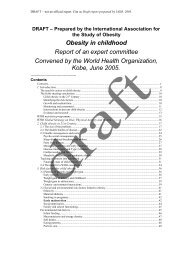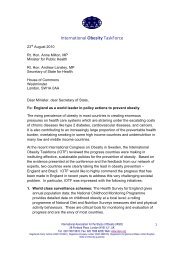COURSE GUIDE - International Association for the Study of Obesity
COURSE GUIDE - International Association for the Study of Obesity
COURSE GUIDE - International Association for the Study of Obesity
You also want an ePaper? Increase the reach of your titles
YUMPU automatically turns print PDFs into web optimized ePapers that Google loves.
Speaker Presentation SummariesTHURSDAY 28TH JULY 2011Stephan Rössner<strong>Obesity</strong> 2011 – Where are we today?There is an old story about a scientist who happily submitted hispaper to a journal and got a letter back from <strong>the</strong> Editor. It read:Thank you <strong>for</strong> your manuscript. It was both new and interesting.The problem is that what was new was not interesting and whatwas interesting was not new.Clearly <strong>the</strong> in<strong>for</strong>mation explosion concerning all aspects <strong>of</strong>obesity has increased - but what is really new and interesting?The explosion is witnessed by <strong>the</strong> fact that we now have severalscientific journals, focusing on various aspects <strong>of</strong> obesity andmore to come. When <strong>the</strong> second journal OBESITY was launchedby NAASO in <strong>the</strong> 1980ies <strong>the</strong>re was severe concern that <strong>the</strong> Int J<strong>Obesity</strong> would be killed by <strong>the</strong> competitor- which certainly did nothappen. Today about half a dozen journals flourish…Although some experts have argued that <strong>the</strong> obesity epidemichas come to a halt, o<strong>the</strong>rs disagree. On <strong>the</strong> o<strong>the</strong>r hand, itis obvious that we have never had so many obese children,adolescents and adults in <strong>the</strong> world as today. Journalists <strong>of</strong>tencannot distinguish between incidence and prevalence.It is appropriate that focus has recently been concentrated onprevention and particularly on prevention in <strong>the</strong> young and inadolescents. Clearly it is necessary to start early in life, since<strong>the</strong> prevention studies which have been carried out in adulthoodhave not been encouraging.A few years ago <strong>the</strong> health ministers <strong>of</strong> Europe unanimouslydecided to sign a Charter in Istanbul giving priority to an antiobesity‘war’. In reality most <strong>of</strong> <strong>the</strong>se commitments have notbeen implemented and only a few countries have a strategic orcoherent approach to fight <strong>the</strong> uphill battle.<strong>Obesity</strong> is <strong>the</strong> end result <strong>of</strong> a powerful game and interactionbetween genes which are essentially unchanged from <strong>the</strong> StoneAge to <strong>the</strong> ‘toxic environment’ in which we live today. However, nosingle gene explains more than a minute fraction <strong>of</strong> <strong>the</strong> variation.Taken toge<strong>the</strong>r it could be argued that we can explain about 50%<strong>of</strong> obesity by genetic factors. Clearly some people who happento be genetically well equipped by chance will never get obesewhatever lifestyle habits <strong>the</strong>y exhibit, whereas o<strong>the</strong>rs will fight alife long uphill battle.In most <strong>the</strong>rapeutic fields an increased number <strong>of</strong> effective drugsbecome available with time and development. In this respectanti-obesity pharmaco<strong>the</strong>rapy is in a unique setting. Around <strong>the</strong>millennium we had three well-established drugs available in manyparts <strong>of</strong> <strong>the</strong> world, although no means by all. When rimonabant waswithdrawn numerous drug companies immediately dropped <strong>the</strong>ircannabinoid receptor blocker programmes and when sibutramineleft <strong>the</strong> stage in European countries only orlistat, <strong>the</strong> oldest drug withmodest weight loss effects, remained on <strong>the</strong> market, bringing both<strong>the</strong>rapists and patients back to square one. Numerous compoundswith various moods <strong>of</strong> action are in <strong>the</strong> drug company pipelines,but <strong>the</strong>re is no obvious winner in sight. Hence companies look <strong>for</strong>old compounds, where safety has since long been established andcombine <strong>the</strong>m. A few <strong>of</strong> <strong>the</strong>se may reach <strong>the</strong> market within a year.They have reasonable weight loss effects and seem to be safe.Very low calorie (VLCD) or VLED (energy) diets are beginning tobe used in a more systematic fashion and a number <strong>of</strong> clinicalindications where rapid initial weight loss has positive long termconsequences have been identified.It is easy <strong>for</strong> politicians to demonstrate activity by setting resourcesaside <strong>for</strong> bariatric surgery. The techniques have improveddramatically and consequently postoperative mortality is almostdown to zero. However, repeat operations are common and eventhough many post-obese patients are very happy with <strong>the</strong> effects <strong>of</strong><strong>the</strong>ir weight loss, <strong>the</strong>re still remains several key problems. One <strong>of</strong><strong>the</strong> most important issues to address <strong>for</strong> <strong>the</strong> future is who has <strong>the</strong>responsibility <strong>for</strong> long-term follow-up <strong>of</strong> <strong>the</strong>se patients. Obviouslysurgeons should do what <strong>the</strong>y are expertly trained <strong>for</strong>, namely tooperate. They should not use <strong>the</strong>ir precious time <strong>for</strong> long-termfollow-up <strong>of</strong> patients. However, <strong>the</strong>y have indeed <strong>the</strong> responsibilityto make sure that o<strong>the</strong>rs do take care <strong>of</strong> this follow-up and givepatients consistent support. There is still uncertainty about <strong>the</strong>very long-term consequences <strong>of</strong> bariatric surgery. At <strong>the</strong> outsetsurgeons, dieticians, physio<strong>the</strong>rapists and nurses have assumedresponsibility, but we have little in<strong>for</strong>mation about what will happenten or twenty years in <strong>the</strong> future. Hence it is important that thosewho per<strong>for</strong>m bariatric surgery today make sure that <strong>the</strong>ir patientsare carefully monitored throughout <strong>the</strong>ir lives.The obesity problem is escalating and what may <strong>for</strong>ce moreconcerted action is <strong>the</strong> ensuing explosion <strong>of</strong> Type 2 diabetes.<strong>Obesity</strong> may be ridiculed as self-inflicted and a disease causedby lack <strong>of</strong> willpower, but nobody disputes that Type 2 diabetes isa disease we need to address with <strong>the</strong> utmost importance, notleast <strong>for</strong> its financial implications. More detailed studies about <strong>the</strong>health economic consequences may result in <strong>the</strong> fact that <strong>the</strong>ministry <strong>of</strong> finance ra<strong>the</strong>r than that <strong>of</strong> health takes action!In <strong>the</strong> meantime <strong>the</strong> depressing fact is that whatever miracle curepatients and <strong>the</strong>rapists eagerly await, <strong>the</strong> old tools diet, exerciseand behaviour modification remain cornerstones. Well executed<strong>the</strong>y still remain quite effective tools and are definitely safe.Philip JamesEpidemiology and prevalence <strong>of</strong> obesityMeasuring weight <strong>for</strong> height is taken as an index <strong>of</strong> body fatnessdespite it being recognised <strong>for</strong> decades that <strong>the</strong> proportion <strong>of</strong>body fat differs between individuals, <strong>the</strong> sexes and with age.Pre-Second World War insurance statistics showed that heavieradults had a shorter life expectancy and <strong>the</strong> BMI was routinelyused from <strong>the</strong> late 1970s with an upper limit <strong>of</strong> 25 taken as <strong>the</strong>crude – cut-<strong>of</strong>f point on <strong>the</strong> basis <strong>of</strong> mortality. The BMI 30 waschosen as traditionally a 20% increase above normal was takento specify obesity. The lower limit <strong>of</strong> 18.5 was selected on <strong>the</strong>basis <strong>of</strong> global analyses <strong>of</strong> physical capacity <strong>for</strong> heavy workwith BMI







